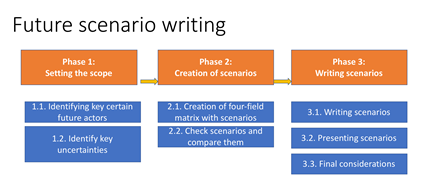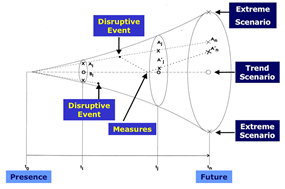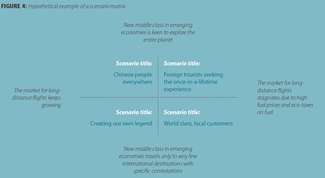Scenario Writing
|
Field of application |
The workshop model can be applied when
|
|
Resume / Brief description
|
The workshop on future scenarios is oriented toward defining different scenarios how the future may evolve under different circumstances. Different possible future scenarios will be developed from the perspective of an organisation, a university programme, a region or a business model. It can be applied to each area which is related to strategic development. The future scenario workshop identifies with the group of specific stakeholders critical uncertainties for future development and based on that defines four possible scenarios. The scenarios are assessed according to their possible implications for a business, a sector, an organisation or a region. The purpose of the future scenario workshop is to become aware and prioritise possible activities according to the different scenarios that might emerge.
|
|
Target group
|
Larger group of students, organisational representatives, CEOs, managers and employees (beyond 10 persons) that want to learn or reflect on how to design different visions for the future and to act with higher sensitivity in the process.
|
|
Objectives |
|
|
Requirements
|
Material
Time
From 90 minutes up to a complete day (depending on intensity and detail)
|
|
Implementation - Overview |
The activity is realised in three main organisational steps.
|
|
Implementation - Guidelines
|
Before the start of the scenario writing, the facilitator and the participants need to define well the topic on which the scenarios should be written. For example, this can focus on students and the business model that they have to develop in their study programmes or on a university that wants to further develop their study programmes.
1. Setting the scope
1.1. Identification of key factors and key uncertainties
The participants are introduced to the future scenario writing exercise, its objectives and perspectives.
The logic is transferred that there is more than one possible future that has to been taken into consideration for strategic development. The difference between a traditional trend scenario and other possible scenarios has to be explained (see figure below)
1.2. Rules of the exercise
The session starts with a reflection of future factors that are given and that are certain. For that the facilitator asks the participants to write cards on the following question: "What are the factors related to the topic that are given and certain, and that will guide the behaviour of people and the evolution of things in the future?" This includes not only laws and policies, but also megatrends, such as globalisation, digitalisation, and technological innovation.
The cards are pinned on the pin board and clustered according to topics.
The facilitator then asks the participants to write cards on the following question: "What are the factors that will impact your focal area and where we are not sure how they will evolve in the future?"
The cards are pinned on the pin board and clustered according to topics.
2. Creation of scenarios
2.1. Creation of four-field-matrix
Participants prioritise the cards on the pin board with key uncertainties according to
For that they discuss first the cards and then vote e.g. with dots or different coloured markers on the cards to identify the factor with the highest possible impact and the factor with the highest likelihood of occurrence.
The group then agrees on the two factors that score highest on each area and finds two opposing expressions for them. This is then the basis of a matrix that might look like in the following example from tourism.
2.2. Check scenarios and compare them
Participants look at the scenarios and reflect: "Are these the ones with the highest impact and the most probable occurrence?"
The facilitators lead to the four scenarios without judging them. They all might have positive elements on the future of the specific business or organisation, just under different factor conditions.
3. Writing and presenting scenarios
3.1. Writing scenarios
The participants create four working groups. Each of them elaborates on one scenario. The scenario is supposed to be a future event or development, e.g. ten years from now. This encourages a creative thinking process where participants do not extrapolate from the present into the future but rather put themselves into the future and trace back how they got there. Participants are encouraged to come up with a creative title for their scenario.
The instruction for each working group are as follows:
3.2. Presenting scenarios
Each group is presenting the scenario to the others and asks questions to the other group to encourage deeper reflection.
Groups can add headlines and titles to substantiate their story.
4. Final reflection
The participants look at the complete matrix and all the scenarios and reflects on the question: "How can we anticipate future trends? What are indicators that provide us with first signs of information?"
The second reflection goes around the following question: "What can we do now to prepare for the future with knowing that there are different possible scenarios? What actions can be taken in the short and medium-term? |
|
Templates, Graphics for download |
n/a |
|
Additional format/references
|
More information on scenario writing can be accessed at: http://www.foresight-platform.eu/community/forlearn/how-to-do-foresight/methods/scenario/
|




No Comments